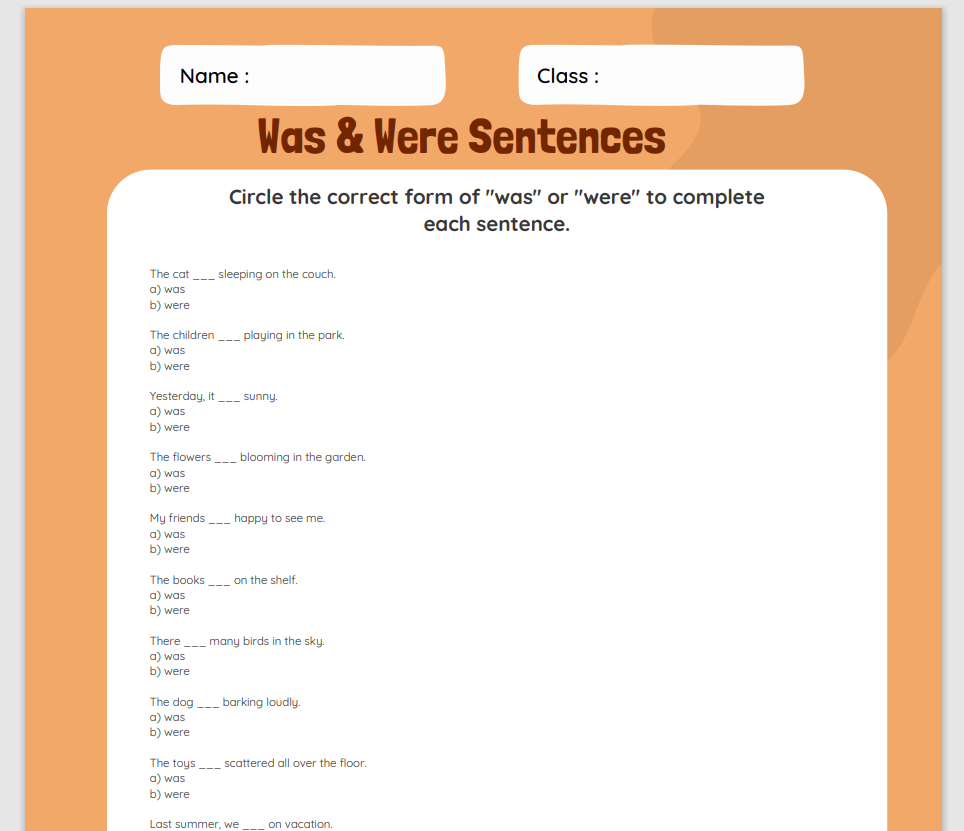Was Were Worksheet for Class 2
Learning proper grammar at a young age is crucial for language development. In English, understanding the usage of "was" and "were" is fundamental. This article aims to provide a comprehensive guide, including worksheets, for class 2 students to master the usage of "was" and "were."
In English, "was" and "were" are past tense forms of the verb "to be." They are used differently depending on the subject of the sentence.
-
Was: "Was" is used with singular subjects (I, he, she, it, or any singular noun).
- Example: She was happy yesterday.
- Example: I was at the store yesterday.
-
Were: "Were" is used with plural subjects (we, you, they) and also with the singular pronoun "you" in a formal context or when addressing more than one person.
- Example: They were playing in the garden.
- Example: You were late for the meeting.
- Example: We were all excited for the trip.
It's important to remember that "was" and "were" are used to indicate past tense. Here's a breakdown of their usage:
- Was: Use "was" when the subject is singular.
- Were: Use "were" when the subject is plural or when referring to "you" in a formal context or addressing more than one person.
However, there are some cases where "were" can also be used for hypothetical or unreal situations, which is known as the subjunctive mood. For example:
- If I were rich, I would travel the world.
Here, "were" is used with the singular subject "I" in a hypothetical situation. This construction implies that the speaker is not currently rich but is imagining what they would do if they were.
In summary, "was" is used with singular subjects, and "were" is used with plural subjects or with the singular "you" in formal contexts. Additionally, "were" can be used in hypothetical or unreal situations in the subjunctive mood.
Importance of Learning "Was" and "Were"
Understanding when to use "was" and "were" forms the foundation of constructing meaningful sentences. "Was" is used with singular subjects, while "were" is used with plural subjects. Knowing these distinctions enhances communication skills and comprehension.
Basic Usage of "Was" and "Were"
"Was" is utilized in sentences referring to singular subjects or singular pronouns (e.g., I, he, she, it), while "were" is employed for plural subjects or plural pronouns (e.g., we, you, they). For instance:
- She was happy yesterday.
- They were playing in the park.
Examples of "Was" and "Were" in Sentences
- The cat was sleeping on the couch.
- We were watching a movie last night.
- He was studying for his exam.
- They were cooking dinner together.
Exercises for Practicing "Was" and "Were"
To reinforce learning, here are some exercises:
- Fill in the blanks with "was" or "were" in the following sentences:
- I ___________ at the park yesterday.
- They ___________ excited about the trip.
- Rewrite the sentences using "was" or "were" correctly:
- Sarah and Tom is playing in the garden.
- I are studying for the test.
Common Mistakes to Avoid
Confusion often arises when deciding between "was" and "were." One common mistake is using "was" with plural subjects or vice versa. Encourage students to pay attention to the subject's number when selecting the appropriate form.
Fun Activities for Reinforcement
Learning can be enjoyable with interactive activities such as:
- Role-playing scenarios using "was" and "were."
- Creating a story collectively, incorporating "was" and "were."
- Singing songs or rhymes with "was" and "were" usage.
Tips for Teachers and Parents
- Provide visual aids and examples to illustrate the concept.
- Offer ample practice opportunities through worksheets and games.
- Offer positive reinforcement and praise to boost confidence.
- Encourage real-life application of "was" and "were" in conversations.
Conclusion
Mastering the usage of "was" and "were" is essential for effective communication in English. By providing structured learning materials and engaging activities, class 2 students can grasp these concepts with confidence.
Unique FAQs
-
Why is it important to learn "was" and "were" at an early age?
- Learning grammar basics early sets a strong foundation for language skills development, aiding in effective communication.
-
What are some common errors students make with "was" and "were"?
- Common mistakes include using "was" with plural subjects or "were" with singular subjects.
-
How can parents help their children practice "was" and "were" at home?
- Parents can engage children in daily conversations and activities that incorporate the usage of "was" and "were." Additionally, they can provide worksheets or online resources for extra practice.
-
Are there any online resources available for additional practice?
- Yes, numerous educational websites offer interactive exercises and printable worksheets specifically designed for learning grammar concepts like "was" and "were."
-
Can improper usage of "was" and "were" affect comprehension?
- Yes, using the incorrect form of "was" or "were" can lead to confusion in understanding sentences, affecting overall comprehension and communication skills.

